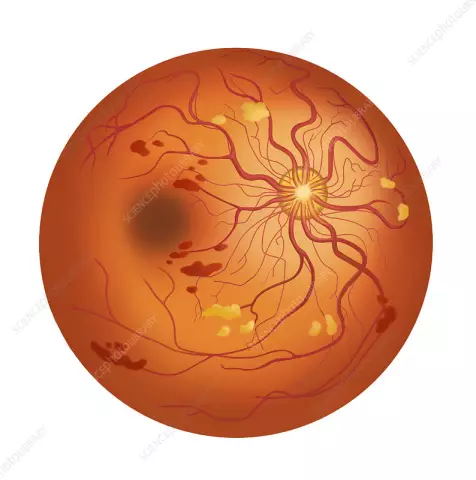- Author Rachel Wainwright [email protected].
- Public 2023-12-15 07:39.
- Last modified 2025-11-02 20:14.
Angiopathy
Brief description of the disease

With angiopathy, the tone of the blood vessels is disturbed. This is due to a disorder of nervous regulation. This disease is manifested by a tendency to dystonia, it can turn into vasospasm.
Angiopathy is most often affected by people whose age threshold has crossed the 30 mark.
Angiopathy can be of several types:
- hypertensive;
- diabetic;
- hypotonic;
- traumatic
Adolescents may have juvenile retinal angiopathy.
Retinal angiopathy
With retinal angiopathy, there is a modification of the vessels that are located in the fundus. If a person has a disease such as hypertension, then he very often suffers from unstable blood pressure and from functional vascular disorders. This is what can contribute to the development of retinal angiopathy.
With angiopathy of the retina, the occurrence of spasms of the arteries is observed, a yellow spot may appear on the eyeball (the so-called Gvist symptom). In addition, with retinal angiopathy, a person can feel the pulsation of blood in the vessels of the fundus.
Diabetic angiopathy
Diabetic angiopathy affects people who have been diagnosed with diabetes. With this type of angiopathy, small and large vessels are affected. Vascular walls are damaged, hemostasis is impaired. Most often, such processes occur in the vessels of the retina, the glomerular blood capillaries of the kidneys, in the vessels of the heart, in the arteries of the lower extremities.
In these cases, a thickening of the basement membranes is observed, mucopolysaccharides begin to be deposited on the walls of the vessels, this leads to the fact that the lumen of the vessel is narrowed and ultimately its blockage can occur. These changes lead to a deterioration in microcirculation, which, in turn, leads to tissue hypoxia.
Diabetic angiopathy of the lower extremities has its own characteristics. Sensitivity may be lost, polyneuritis of varying degrees is expressed (burning, numbness of the foot, pain syndrome), ulcers may appear, in the most severe cases of diabetic angiopathy, gangrene of the toes is possible. But if a person seeks medical help in time, such an outcome is practically impossible.
Hypertensive angiopathy
At the heart of hypertensive angiopathy are the consequences of hypertension. These can be dilated veins, which can be observed in the fundus, branching of the venous bed, punctate hemorrhages that can be observed on the surface of the eyeball.
With the advanced stage of hypertensive angiopathy, changes are already taking place in the retinal tissues, punctate hemorrhages in the eyeball occur frequently, and retinal opacities are also observed in different places. If the patient's hypertensive phenomena are eliminated, then the fundus will again acquire a normal, healthy appearance.
Treatment of angiopathy

In the treatment of angiopathy, drugs are used as prescribed by a doctor. To improve blood microcirculation, the doctor may prescribe pentylin, arbiflex, trental, solcoseryl, vasonite, and other drugs. These drugs contribute to the bendability of erythrocytes, this is necessary so that erythrocytes can freely pass through the capillaries.
For the treatment of angiopathy with increased fragility of blood vessels, calcium dobesylate is prescribed. This drug improves blood microcirculation in blood vessels, reduces blood viscosity, and helps to normalize vascular permeability.
For the treatment of diabetic angiopathy, in addition to medications, the doctor prescribes a special diet, excluding foods rich in carbohydrates from the diet. It also recommends that the patient include a little physical activity. Physical activity promotes the consumption of sugar by the muscles, improves the functioning of the cardiovascular system of the body.
In addition to the use of drugs in the treatment of angiopathy, physiotherapeutic methods are used, such as laser irradiation, magnetotherapy, acupuncture.
If angiopathy is in advanced state, it is highly likely that it will be necessary to purify the blood using hemodialysis.
YouTube video related to the article:
The information is generalized and provided for informational purposes only. At the first sign of illness, see your doctor. Self-medication is hazardous to health!






